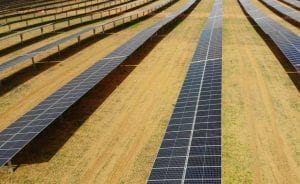Melbourne-based investment fund UniSuper has become the cornerstone investor in the World Bank’s first green bond issue into the Australian market, snapping up one-third of the $300 million five-year, fixed rate Australian dollar denominated debt securities, designed to mobilise private sector funding for environmentally and socially responsible projects.
The $40 billion super fund will make the $100 million in Green Bonds available to institutional investors through its Socially Responsible (SR) Balanced option, as a means to support the development of clean energy, mass transit, and other low-carbon projects.
Last month, UniSuper announced it would exclude fossil fuel companies from its “socially responsible” investment options as part of a refocus of its portfolio. Tobacco was excluded from all its investment options in 2012, and there are plans to exclude gaming and weapons stocks in the future.
This latest move follows the release this week of the IPCC’s first detailed chapter on climate finance, advising that by redirecting investment flows from heavy-emitting energy sources to low-carbon sources, global warming could still be limited to 2°C.
The call was backed by Nathan Fabian, chief executive of the Investor Group on Climate Change Australia/NZ, who stressed that the redirection of the $1.2 trillion already invested each year in the energy sector was “the key task for governments and investors.”
World Bank vice president and climate special envoy Rachel Kyte has similarly described the role of green bonds in low-carbon investment as crucial, but says their broader role – “to move the finance fulcrum in a cleaner direction, away from traditional fossil fuel investments” – is even more important.
At the World Economic Forum in Davos this year, World Bank Group President Jim Yong Kim called for a doubling of the Green Bond market to $20 billion by September, when the UN convenes a high-profile climate summit; and to at least $50 billion by the time of the UN climate negotiations in Paris in December 2015.
Certainly, the global green bond market has been growing rapidly. Since its first issue in 2008, the World Bank has mobilized over $5.3 billion through 61 green bond transactions in 17 currencies, and the IFC has issued $3.4 billion in green bonds, including two $1 billion issuances in 2013.
In France, a new green bond issue by energy company EDF in December showed that an unprecedented depth of interest, with the €1.4 billion issuance two-times oversubscribed from the start.
And just this week, the French regional government that oversees Paris, Île-de-France, issued their second green bond – or Green & Sustainability Bond – of €600 million for 12 years. As Climate Bonds’ Sean Kidney wrote, they went to market looking for €350 million, but after one hour closed with €750 million of orders, and ended up issuing €600 million. “I guess we can take that as another market signal,” said Kidney.
Earlier this month, Canada issued its first corporate green bond – and the world’s second green bank bond (Bank of America was the first); a $C500 million, three-year, fixed interest bond from TD Bank whose proceeds will be allocated to green investments.
Of particular interest, notes Sean Kidney, “is that TD issued two bonds at the same time: a standard bond at 5 years, and the green bond at 3 years. Both bonds were over-subscribed and pricing was similar. The green bond was 1.5 times over-subscribed and attracted 39 investors, 12 of whom were new investors to TD.”
No doubt UniSuper is looking to achieve similar results. “This AAA-rated high quality bond investment is designed for members that want to drive positive environmental and social outcomes,” said Talieh Williams, UniSuper’s Manager, Governance and Sustainable Investment, in a statement on Thursday. But it will need to attract investors for the most old-fashioned of reasons, too.
“Given the depth of capital invested in the global superannuation industry seeking long term, low risk, higher yield investments, the Green Bond market has huge potential to unlock capital for investment in the transition to a low carbon energy system that is rapidly emerging,” said Blair Palese, CEO of 350.org Australia, which has been driving the fossil fuel divestment campaign that has targeted university super funds.
Meanwhile, the closest thing to resemble a green bank in Australia, the Clean Energy Finance Corporation, remains on the Abbott government chopping block, despite its claim it can deliver half of the nation’s carbon abatement target and still turn a profit for the government.
The CEFC, which has so far been protected from the Coalition’s repeal bill by the Labor/Green majority in the Senate, says it has allocated $700 million in funds and unlocked finance for $2.5 billion in projects since it began formal operations on July 01 2013 – and is having a close look at another $3 billion worth.







